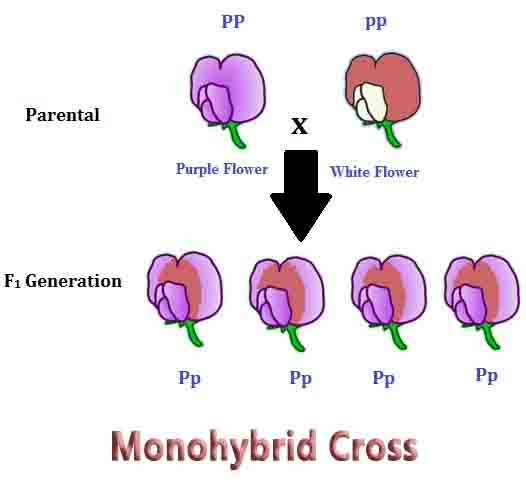Monohybrid Cross Definition
A monohybrid cross is a genetic mix between two individuals who have homozygous genotypes, or genotypes that have completely dominant or completely recessive alleles, which result in opposite phenotypes for a certain genetic trait.
Monohybrid crosses are used by geneticists to observe how the offspring of homozygous individuals express the heterozygous genotypes they inherit from their parents. Typically, this mix determines the dominant genotype.
A monohybrid cross can also signify a genetic mix between two individuals who have heterozygous genotypes. These crosses confirm the dominance of an allele
Examples of Monohybrid Cross
Gregor Mendel’s Peas
Although he did not know it at the time, Gregor Mendel used monohybrid crosses to identify dominant and recessive traits in his landmark experiments with peas.
Gregor Mendel focused on several different genetic traits, but we will focus on one: stem length. Imagine that two types of pea plants grow in a garden. One type of pea plant has long stems, while the other has short stems. For the sake of this example, assume that both types of pea plant have a homozygous genotype (LL and ll), and that long stems (LL) are dominant over short stems (ll).
A monohybrid cross, or breeding a long-stemmed pea plant with a short-stemmed pea plant, allows scientists, like Gregor Mendel, to determine the dominance of long stems or short stems. A monohybrid cross also permits scientists to evaluate how heterozygous offspring express the genes they inherit.
As mentioned before, breeding a long-stemmed pea plant with a short-stemmed pea plant creates offspring that all have a heterozygous genotype (Ll). As long stems are dominant, all offspring will have the long-stemmed phenotype. In different terms, and as modeled by Gregor Mendel’s classic pea example observing the offspring of a monohybrid cross allows for determination of dominant genotypes and, by extension, dominant phenotypes.
Huntington’s Disease
Huntington’s Disease is a progressive degenerative condition that occurs in 4 to 15 of every 100,000 people in the United States. Having no cure, it is a certain death sentence for those diagnosed. While little is known about this condition, geneticists are sure that it is inherited via a dominant gene.
At the simplest level, a monohybrid cross was used to determine the genetic nature of Huntington’s disease. Everyone carries the aptly-named Huntingtin gene, the gene responsible for the complication. With this information, scientists paired the Huntingtin genes of an individual who is homozygous dominant for the condition (HH) with the Huntingtin genes of an individual who is homozygous recessive for the condition (hh).
Although this example is highly abridged, the result remains that all offspring from the cross carried the dominant allele for Huntington’s disease. While this experiment, if conducted on humans, would bring sad news to both parent and child, it would also highlight the dominant nature of the disease.
Confirming Dominant Traits
We have already discussed how scientists use monohybrid crosses to determine the dominant allele of a genotype. However, monohybrid crosses between homozygous individuals is often only the first step. Heterozygous crosses, in which both parents carry a dominant allele and a recessive allele, helps confirm whether a trait is dominant or recessive.
The model for this second step greatly resembles the process Gregor Mendel followed, with peas. Using stem length as an example, scientists breed two parents that both have long stems, with genotype Ll. In an ideal scenario, one in every four of their offspring will carry the genotype ll, and thus have a short stem.
Because long stems occur more often than short stems in this second iteration, scientists can reasonably determine long stems are a dominant trait.
Related Biology Terms
- Genotype – The genetic code one inherits for a specific trait.
- Phenotype – The physical manifestation of a specific genetic trait that signals the inheritance of certain genetic codes.
- Homozygous – A genotype carrying two dominant or two recessive alleles. One allele is inherited from the father, and the other, from the mother.
- Heterozygous – A genotype carrying one dominant and one recessive allele.

